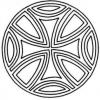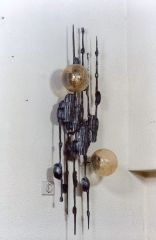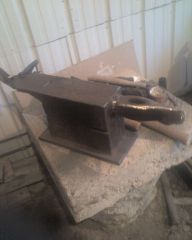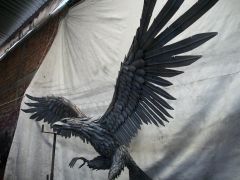-
Posts
539 -
Joined
-
Last visited
Content Type
Profiles
Forums
Articles
Gallery
Downloads
Events
Everything posted by Tim McCoy
-

found cheap anvil anybody recognize it?
Tim McCoy replied to scottorious's topic in Anvils, Swage Blocks, and Mandrels
Saw a complete anvil/vise combo about two weeks ago at a yard sale. Same anvil piece as yours with vise portion entering from the side away from the conical edge of the "anvil" and entire unit was in excellent condition for $25. Not something to be beating with any vigor ... ;) -
For those of us who don't know what a Habermann Bend looks like could you share a clearer photo of the spring ... please.
-
Have you seen the "Striking Vise" thread under tools ... another creation by Brazeal & LDW?? That thread started after yours did. Might be just the ticket for your vice.
-

polishing a clay hardened knife blade
Tim McCoy replied to NickWheeler's topic in Finish and Polish for Knives
Great info - hey, does anyone else think that this would make a acceptable BP?? -
Agreed ... replace leaking air compressor tanks. Making a repair for yourself IMHO is an experiment in terror ... it either works or it doesn't ... no inbetween :blink:
-
I second the wow!! A very interesting piece :D
-

Anyang Factory Visit
Tim McCoy replied to Jamesrjohnson's topic in Power Hammers, Treadle Hammers, Olivers
It was interesting to see how the billet actually bounced off the face of the anvil several times ... great video! -
Good score for the wife Frosty - got it for about 10% of retail I bet :lol:
-
Any smithin' space is fine ... use what you have and make the best of it. Most of the blacksmiths in the world would love to have any kind of roof!
-
A very well spent 8 hours.
-
Try this link ... seems to have all you need ... http://www.jldr.com/ohlieb.html :D
-
All are great work, but the last one with two pieces welded together really does show off your forge welding ability! :o
-

"Chandelier" by Mauro De Biasio
Tim McCoy commented on Francesco De Biasio(Italy)'s gallery image in Smithys
-
I've seen video of forming shapes like that on both an english wheel and by using a plastic or leather faced mallet striking the metal against a bag of sand ... nothing with that diameter though ... great start!
-
Dodge I saw your first postings for that anvil - great that you have finally finished it. Mild steel or not you should be very proud of what you have accomplished. Few of us could replicate an anvil that has the lines your build up has. Your work reflects your imagination, patience and skill. Thanks for the update! It makes me eager to get to welding on my fork lift tine anvil.
-
Maybe if there was a tent event some of us could donate some saleable items to generate cash to pay for the space and perhaps a little operating cash for IFI ... key fobs, crosses, candle holders, punches, etc. you know one of those USPS one rate boxes could hold a lot of stuff.
-
IMHO I really like the idea of an IFI tent at some other events ... start small, get some idea of the real (people actually showing up) interest and build on that. Or more of us start making it a habit to meet other IFI'ers while traveling and document that at this location ... photos, etc. Even if several people only got together here and there as they could and used their connection to the IFI community the larger blacksmithing arena would benefit. Sometimes loosely knit groups never become formal even though there seems to be a large number of adherents. IFI numbers still remain divided into distinct groups comprised mainly of those that just "like to watch" and those that like to do and share information and ideas - maybe a 98 - 2% split. Neither group is more important, but it would seem that there are still too few doers to really put together anything like a conference. We are fortunate in that we have our conference available to us every day here at IFI ... it's just that there isn't any bar-b-que here :D
-
IMHO I'd take the Russian ... has all it's parts and although not "classic" it is the better of the two due to it's having all it's parts and allows for more work.
-
For a detailed exploration of the theories covering both gas and fluid flow see the discussion on Bernoulli's Theorum at the follwing link: http://en.wikipedia.org/wiki/Bernoulli_theorem ... Discusses both gas and non-compressible fluids. Fans move air and create flow while straight ducts, convergent ducts, divergent ducts (as exist in a bellows) all have different effects on gasses and cause either increases in pressure resulting in slower flows or decreases in pressure resuliting in faster flow or in straight pipe pressure can remain constant but rate of slow can decrease because of resistance along the wall of the pipe ... Bernoulli's theories explain most of what we see with fluid used in hydraulic pumps, air flow in jet engines and pressure nozzles and the like. A bellows acts as a "jet" by accelerating a gas (our oxygen) through a nozzle (created by the hole that is between the actual bellows and the nozzle that feeds the air into the burning fuel). An internal combustion engine does compress the gasses and fluids fed into the burning chamber (cylinder) but some of the resulting forces are explained by other theories ... who'da thunk that burning some coal could get so complicated? :blink:
-
Glad to have you here! many good things happen on IFI including sharing info about the why and how of blacksmithing. You will find many new friends ... nicely done work on the anvils.
-
IMHO - A convergent duct (area of inlet/passage is decreasing) the pressure on the side of input is increased causing a slowing of velocity and conversely on a divergent duct (area of egress is increasing) the pressure is decreased causing an increase in velocity ... the size of the bellows and the rate at which they are pumped will determine the volume and mass of air pressing against the valve (inlet/passage) to supply air to the fire. As the air passes through the inlet/passage to the fire the pressure drops allowing the air to travel at a faster rate. Bellows volume/size, the rate at which it is refilled and emptied, the size of the hole allowing the air to reach the pipe going to the fire will all determine the efficiency of the "bellows". It is how a jet engine works and why air coming out of a small nozzle goes "faster" ... works with fluids also. More air moving across the burning medium makes it burn faster and hotter so volume and speed both are important up to the point that the coal blows out of the hole - es verdad, no?? :lol:
-
A very interesting and different design element. I like the finish/patina job on the SS. How well does the cap/cover work??



